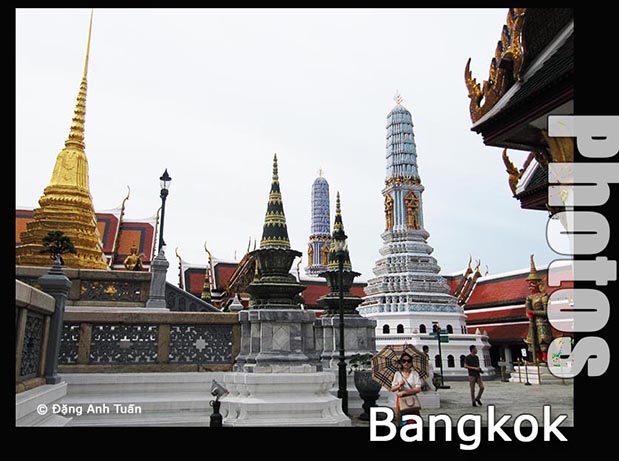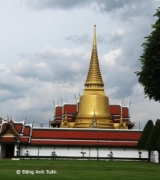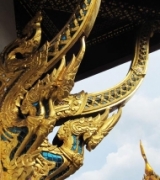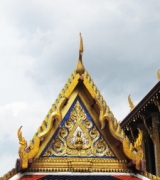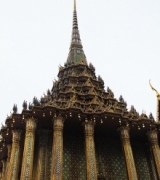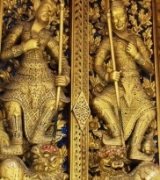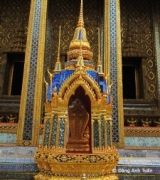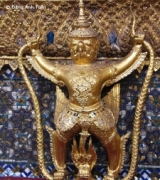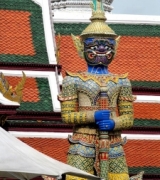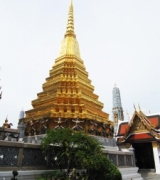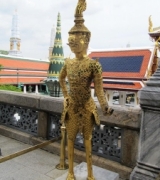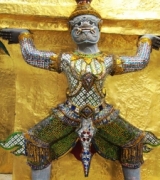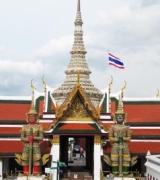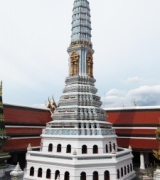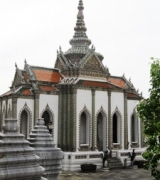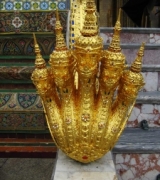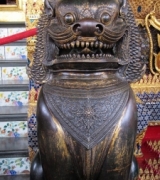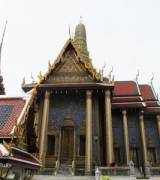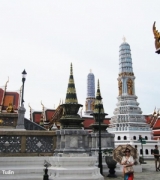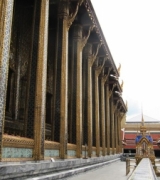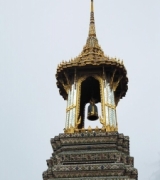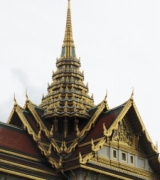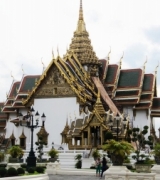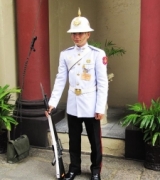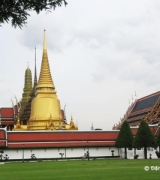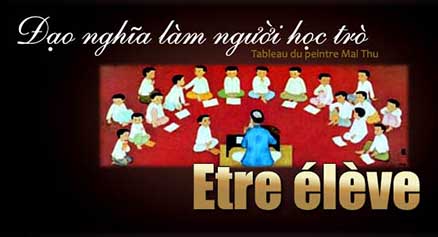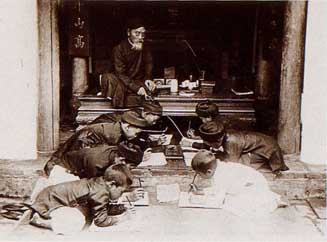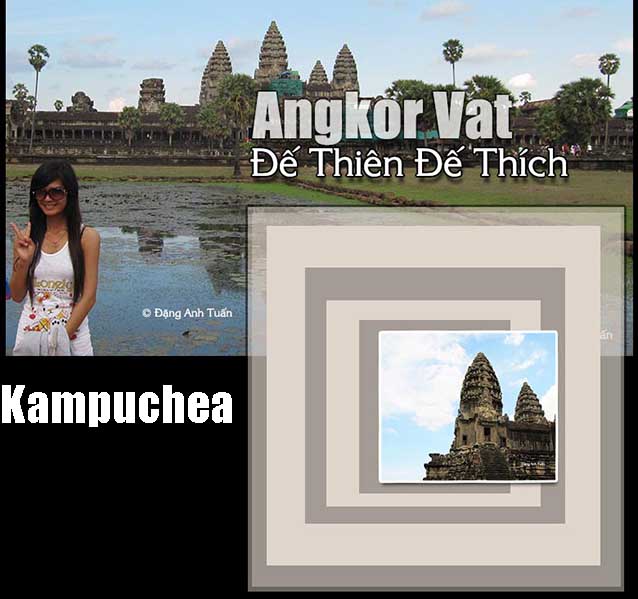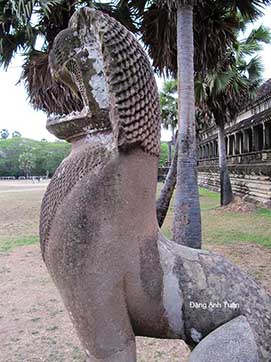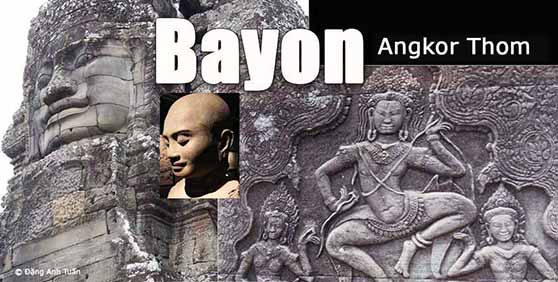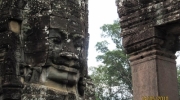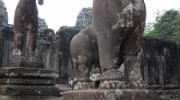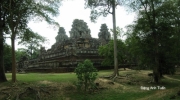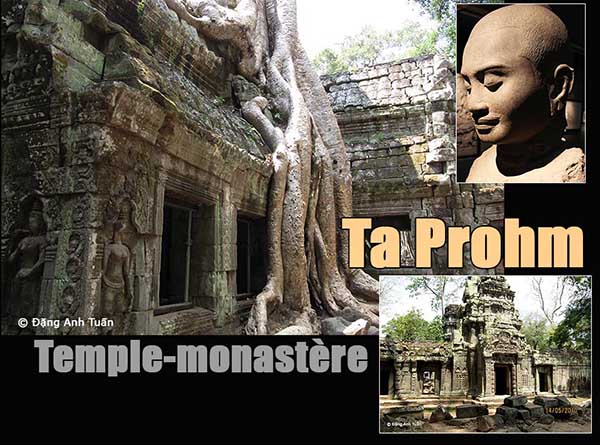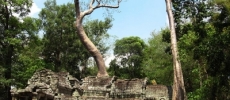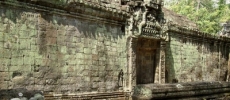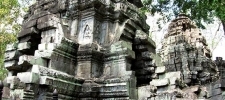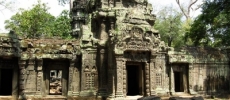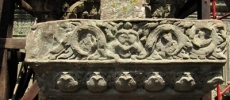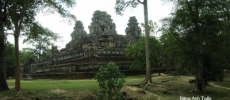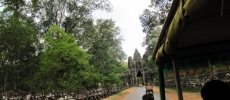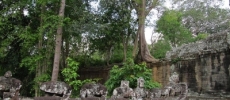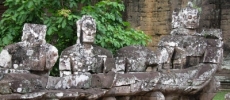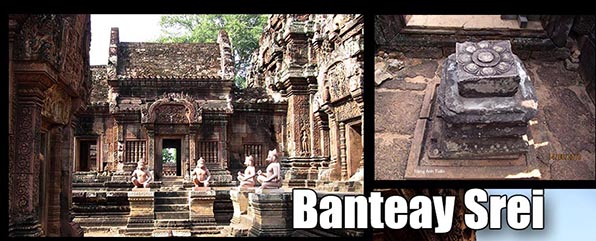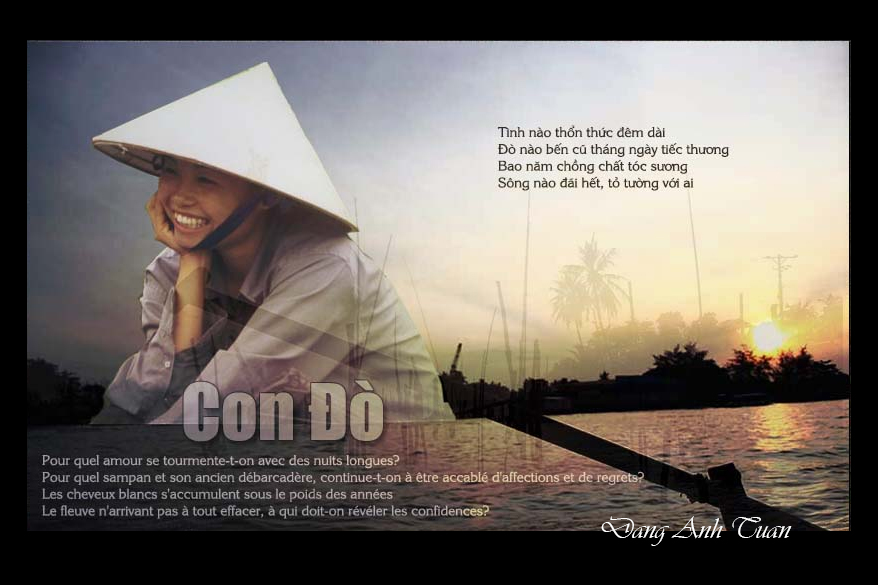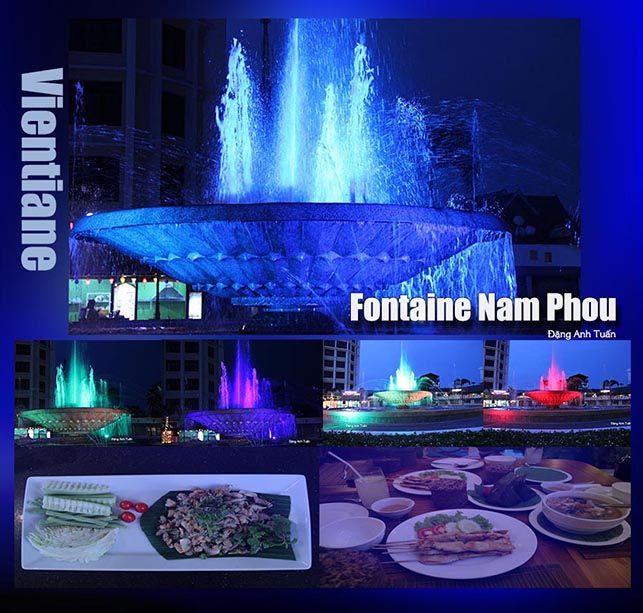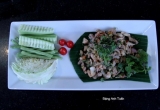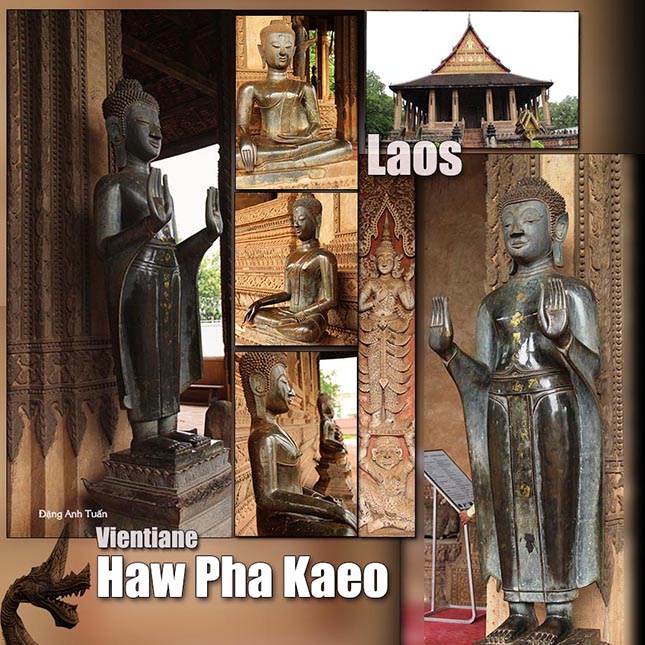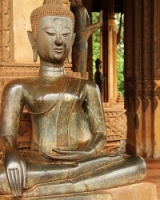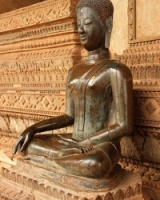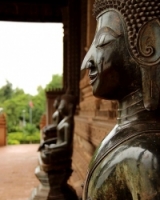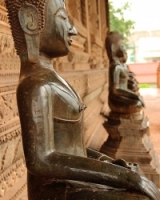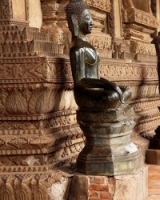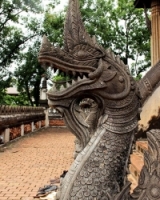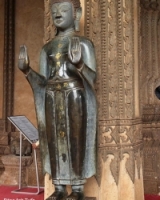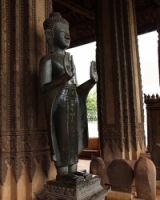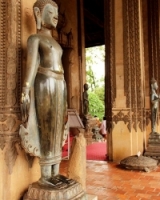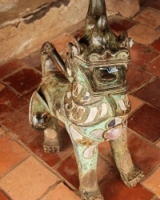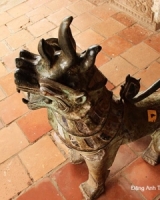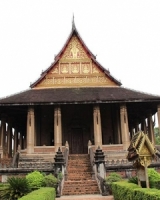Mois : décembre 2016
Being student (Đạo nghĩa làm người học trò)
In memory of my teachers,
the Brothers of Jean Baptiste de la Salle.
Being student in Vietnam
No Vietnamese can remain impassible when it comes to recall the years of study spent at school with their teacher. The image of their school keeps on being intimately carved in their memories.
That is the way composer Phạm Trọng Cầu felt in his song Trường Làng Tôi ( My village school ). How could they forget what has contributed in giving them their education, teaching them, and putting them on the road of apprenticeship in life? For them, one word taught by or one day of study with their teacher is enough to justify the obligation toward him.
Trường Làng Tôi ( My village school )
That is why it was repeated time and again when they were young that
Nhất nhật vi sư
Bán tự vi sư
Học một ngày cũng thầy
Học nữa chữ cũng thầy
The one who teaches us for one day or even half a word is worth being our teacher. Without the teacher, they cannot become who they are today. They owe him part of their life, their success and above all their education because it is him that gave them not only knowledge but also taught him the wisdom and apprenticeship of life. The following famous remark : Không thầy đố mầy làm nên ( Without the teacher you cannot succeed ) continues to occupy their mind and justify their behavior, their deep feelings toward their teacher. They give him such a crucial role that they do not hesitate to use the word « teacher » ( or Thầy in Vietnamese ). Thầy is sometimes used to address the father because it is he that gave them the first lesson in education. That is why the teacher remains the second person to be respected in the unchanging following Confucian trilogy: Quân, Sư, Phụ.
Whichever their age, position and level of education, they continue to remain the little pupil, the young disciple of their teacher.
They are not willing to neglect their respect toward their teacher even in moments the most perilous in their life. This was shown by emperor Hàm Nghi toward his teacher before the colonial authorities who were not able to identify Hàm Nghi physically when he was captured. The only person who could identify him was his teacher; therefore the latter was brought by force before the young Hàm Nghi. For the respect of his old teacher, he could not let him kneel down. He was obliged to prevent his teacher from executing this gesture. Because of this inopportune attitude, he was thus identified by the colonial authorities. He preferred to die instead of making an irreparable mistake toward the one who had taught him not only dignity and courage but also the duty toward his people and country. It was also the case of emperor Duy Tân with is tutor Eberhard in charge of supervising and reporting all his activities to the colonial authorities. Instead of being hated, he became one of the people that Duy Tân continued to respect during his reigning years. It was a habit to say in Vietnamese:
Kính thầy mới được làm thầy.
We should respect our teacher before becoming a teacher later.
It is in this Confucian spirit that young Vietnamese students were raised. They always try to listen to their teacher. They sometimes adopt an ambiguous attitude so as not to vex or bother their teacher even though when they are not entirely in agreement with him. It is the respect that emperor Gia Long knew how to maintain toward his tutor and spiritual guide, the bishop of Adran, His Highness Pigneau de Behaine during his reigning years. Age is not a factor in the behavior of a student toward his teacher who in several occasions was younger than him. It is shocking and moving to see sometimes an old student crossing arms in front of a young teacher but that never contradicts the intimate sentiments, the profound and sincere attachment he continues to keep for his teacher the way he does for his mother and his country. He knows what his teacher expects from him. He tries to keep up with this expectation, which sometimes puts him in a delicate and aberrant situation where he is himself in competition with his teacher.
It was the case of Phạm Duy Tri with his teacher Nguyễn Khắc Kínhduring a royal examination that took place in 1562 under the Mac dynasty. Issue of a very poor family and orphan of father at very early age, he was raised by his mother who did not hesitate to offer the teacher the only buffalo she possessed in order for the latter known for his years of experience in teaching in the village, to accept her son as his disciple. Moved by this mother’s sacrifice, teacher Nguyễn Khắc Kính agreed to take him as his student. A few years later, thanks to his assiduity and intelligence, he ended usentiments the latter always reserved for him, he did not want his student, because of the respect he had toward him, to be penalized and wop in surpassing his teacher, which the latter saw during the provincial and general exams where he was himself a candidate. Knowing perfectly well his student’s state of mind and his profound uld not put all his weights and ardor in the royal examination. For that, he told his student:
If you do not want to be brilliant in that exam, I would understand your behavior, your feelings. But you have to remember that this examination is reserved for the one who deserves to be chosen to serve the country. You must take into account the interest of the nation before any personal considerations. You should not betray your ideals and your country.
He reminded him the sentence that any school teacher would repeat to his student:
Bất nhượng ư sư
Không nên nhường thầy.
Do not concede to your teacher what you deserve.
Moved by the advice, Phạm Duy Tri nodded his head and kept what his teacher had told him. He passed the royal exam and acquired the title of Trạng Nguyên ( 1st doctor ). As for his teacher, he was classified second and received the title of Bảng Nhãn ( or 2nd doctor ).
The feelings that a Vietnamese has for his teacher never fade with the time, which was shown by lord Nguyễn Phúc Nguyên toward his spiritual teacher and counselor Ðào Duy Từ. To thank him, lord Nguyễn Phúc Nguyên did not hesitate to grant him a vibrant homage by giving to one of his fortifications located in central Vietnam the name « Lũy Thầy » (fortification of the Teacher ). This fortification was built to counter the Trinh from the north. Thanks to this naming, he was successful in giving gratitude a wide range through history and the entire nation. Today the fortification is still known by this name.
On the other hand those feelings become as the time goes by a kind of cement that link a Vietnamese a little more to his school, his village and his native country. They are also a gift of affection and respect that Vietnamese love to give their teacher in the Confucian spirit.
Angkor Vat (Temple-Mountain)
Jewel of Khmer Art
It is the largest and the most sublime temple-mountain of all Khmer temples. It was built during the reign of Sûryavarman II in the first half of the XIIth century. It was considered as capital of the Khmer empire having in its center the temple of state dedicated to Vishnu. It is here that the towers are raised in quincunx. Two major characteristics of the Khmer architecture are found there: pyramids or temples-mountains symbolizing the Mount Meru (house of Gods) and the galleries which were built the one above the other. Many people considers it as the eighth wonder of the world. Other temple mountains can be visited: Bakeng, Takeo, Baphûon, Prè Rup, Bakong and Ak Yum.
no images were found
Bayon temple (Angkor Thom)
Bayon is the central temple of the old city Angkor Thom, capital of Khmer sovereigns at the beginning of the XIIIth century. It is the last one of temples-mountains built by king Jayavarman VII, restorer of royal power of the Khmer Angkor kingdom after the invasion of the Cham. Its decoration of a exceptional wealth is at the apogee of Mahayana Buddhist art.
This king dedicates this monument to Buddha he spreads the doctrine of which with his face towers. There are over 37 harmonious towers around a big central tower, the sanctuary. But we think that they could be more numerous, perhaps 54 towers with 216 faces according to French Paul Mus.
King Buddha at Guimet museum

These towers are built by putting stony blocks piled on top of the other without any cement. The sculpture will be made after the completion of placement of these rocky blocks.
What mechanical strength did they have, the Cambodians in the past, to raise the enormous stony blocks until higher parts of the building after having extracted them from the distant mountains, having polished and sculptured them? It is this question which haunted frequently Henri Mouhot during the discovery of Angkor ruins. We find on four sides of each tower, gigantic faces in the enigmatic smile, each one of them turned respectively to one of the four cardinal points.
The visitor has the impression to be followed by their glaucous look. For Pierre Loti, Bayon was the heaviest stony mountain the men dared to undertake since the pyramids of Memphis.

In his work entitled « Travel in the kingdoms of Siam, Cambodia, Laos and other central parts of Indochina « , the discoverer of the Angkor ruins, Henri Mouhot, left his impression: In spite of the disappearance of the gold and colors which almost totally removed from the building, there are only stones there. But these ones proclaim loudly the genius, the strength and the patience, the talent, the wealth and the power of the Cambodians in the past.
We discovered recently during a excavation realized in 1933, in the broken remains of a big stony statue 3,60 m in height, the representation of Jayavarman VII in king Buddha. The builder of the Bayon, is seated, legs tucked on the coiled body of the naga. Since then, we attributed this face with the mystic smile found on the sides of the Bayon towers to that of Jayavarman VII.
Ta Prohm (Temple-monastery)
Great king Jayavarman VII
Unlike most of the temples of Angkor, Ta Prohm was left in a state of ruin. It was deliberately chosen by the École française d’Extrême-Orient (French School of Oriental Studies) as an example of what the temples of Angkor looked like at the time of their discovery in the XIXth century. For building this temple, the sovereign Jayavarman VII relied upon the income which the rice culture gave him. The money did not exist at that time. The currency of exchange remained the rice, the basic food of the workers enlisted to build the temple. We find in the Ta Prohm site an inscription indicating that 12 640 people served in this single temple.
It also reports that more than 66 000 farmers produced more than 2 500 tons of rice a year to feed the multitude of priests, dancers and workers in the temple. Because of its romantic attraction, the Ta Prohm temple was selected in the American movie Tomb Raider with Lara Croft (Angela Joli).
Đền – Tu viện Ta Prohm
It is here that the nature took back her rights. Certain walls of the Ta Prohm site can only stand up thanks to the roots of fig and cheese trees who enclose them as huge octopuses. Ta Prohm is considered as one of the temples the most appreciated in Angkor. It was built by great king builder Jaravarman VII at the end of the XIIth century. It was dedicated to his mother because we find the surprising resemblance of this one in the statue of the main divinity in this temple, Prajnaparamita (Perfection of the wisdom). His father was not either forgotten because Lokeçvara, the main god of Preah Khan looks like him enormously.
Banteay Srei (The jewel of Khmer art)
Banteay Srei: the jewel of Khmer art
Located 20 km northeast of Angkor and almost at the foot of the mount Phnom Kulên, this temple was built in the Xth century in pink sandstone and in laterite under the reign of Jayavarman V. It is the work of certain Brahman Yajnavaraha, adviser of king Rajendravarman then guru of Jayavarman V. Besides the variety of stoneware (preferred material of the Khmers) in the warm tones of pink, the quality and the beauty of this temple are found in the exceptional delicacy of sculptures and the freshness of its sophisticated decorations. Depending on the period of sunshine, this temple changes colour through the day.
It was discovered by the French people in 1914. It became famous in 1923 when French writer André Malraux was arrested for the dissimulation of 4 apsaras. One gives to this temple a recent appelation naming » citadel of the women » in reference to the delicacy of the sculptured decorations which could have been made only by women or for its small size compared with the other temples. The restoration was made by Henri Marchal between 1931 and 1936 in a remarkable way by using the technique of the anastylose adopted by the Dutch people.
Culinary art ( Nghệ Thuật Ẩm Thực của người Việt)
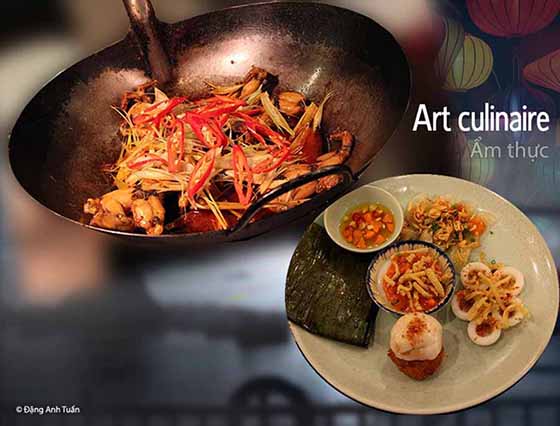
Vietnamese people grant a great importance to the culinary art, in particular to their eating. It is the first necessity in their daily life and culture. Nothing is more amazing to see the use of « an » as the prefix in a great number of words. Among them we find: ăn nói ( to speak ), ăn mặc ( to wear ), ăn ở ( to live ), ăn tiêu ( to consume ), ăn ngủ ( to sleep ), ăn trộm ( to steal ), ăn gian ( to cheat ), ăn hiếp ( to bully ) and so on…It is usually said: Trời đánh tránh bữa ăn to means even God dare not disturb the Vietnamese during their meal.
Their eating is carefully elaborated according to the concept of Yin and Yang and the five elements (Thuyết Âm Dương Ngũ Hành) which serves as the fundamental basis of their Van Lang civilization.
Yin-Yang ( Âm Dương ) is the representation of the two poles of all things, a duality that is at the same time contradictory and complementary. Of the nature Yin is whatever is fluid, cold, humid, passive, somber, interior, female in essence like the sky, the moon, night, water, winter. Of the nature Yang is whatever is solid, hot, luminous, active, exterior, male in essence like the earth, the sun, fire, summer. Human is the hyphen between these two poles or rather between the Earth (Dương) and the Sky ( Âm ). Harmony may only be found in the equilibrium that human brings to its environment, universe and body. Vietnamese food therefore finds all its meticulous preparation and particularity in the dialectic relationship of the theory of Yin and Yang. It also shows the respect of the millennial cultural tradition of a farming country and of a civilization known for its rice farming on flooded rice fields (trồng lúa nước).
Yin-Yang in Vietnamese culinary art
© Đặng Anh Tuấn
That is why rice should not be missed in a Vietnamese meal. It is at the basis of several Vietnamese dishes (bánh cuốn, bánh xèo, phở, bún, bánh tráng, bánh chưng vân vân ) (ravioli, crepe, pho, vermicelli, rice paper, sweet rice cake etc..) Rice can be whole, round, long, crushed, scented, glutinous etc… More than a food, rice is for the Vietnamese people a tangible proof of their Bai Yue culture, a trace of civilization that is not lost under the weight of long Chinese domination.
The manner in Vietnamese eating is not foreign to the search for the middle-of-the-road attitude encouraged in the concept of Yin and Yang. » Eating together » requires in their view a certain respect, a certain level of culture in the art of eating because there exists an undeniable interdependence among the guests in the share of food and space. It is usually said: Ăn trông nồi , ngồi trông hướng.
When eating look for where the rice cooker is and when sitting look for where the direction is. That is the maxim that Vietnamese parents used to tell their children about their table manners. One has to behave oneself when invited to a meal. One should not eat too fast for not to be called impolite but should neither eat too slowly as one should not make other guests wait. Emptying one’s plate or the cook pot is not allowed because it gives the feeling of being greedy. On the contrary, eating too little implies a lack of mannerliness, which may vex the host. This cautious behavior could be summed up by the following statement: Ăn hết bị đòn, ăn còn mất vợ. (Emptying the cook pot deserves spanking, leaving some leftover leads to losing the spouse ). It is in the constant search for equilibrium evoked in the Yin and Yang theory that a Vietnamese must exercise in due course at a meal. It should not be ignored the « varied » nature brought in by Vietnamese food that is characterized by the diversity and visible exuberance in colors of the ingredients in the preparation.
Around a bowl of rice is the creation of a multitude of colors, flavors and dishes. The expression of the 5 senses (ngũ giác) is also found in a Vietnamese meal:
smell: by the release of aromas and flavors of foods served,
sight: by various coloration of the ingredients that go in the preparation of the dishes,
taste: by the flavors of the dishes,
hearing: by the sound made by the sucking of tea or stock with the mouth,
touch: by the nonstop handling of chopsticks.
For some Vietnamese specialties (gà nướng (roasted chicken), gà luộc ( boiled chicken ), gỏi cuốn (spring rolls) ), the use of hand is highly appreciated. Most Westerners used to attribute to the Chinese the holder of chopstick civilization. However it is the product of the cradle of the rice growing civilization of South East Asia. It is what the Chinese historian Ðàm Gia Kiện has written in his book entitled « Cultural History of China » ( Lịch sử văn hóa Trung Quốc ) ( 1993, page 769 ):
At the time prior to the unification of China by Qin Shi Huang Di, the Chinese continued to use their hands to grasp food. It was a tradition found in people growing millet (kê), barley (mạch) and eating bread, hum bao ( bánh bao ) and meat. They only began to use chopsticks during their expansion toward Southern China.
That assertion has been justified by recent scientific discoveries. Chopsticks can only be made in a region where abundance of bamboo is not in doubt. That is the case of Southern China and South East Asia. They are the rudimentary tool shaped to the image of the bird’s bill to efficiently pick up grains of rice and fish without having to soil the hands with the plates containing water (soup, broth, fish cauce etc…). It is found in the Vietnamese use of chopsticks a simple as well as humoristic philosophy. A pair of chopsticks is always compared with a married couple.
That is why one used to say:
Vợ chồng như đôi đũa có đôi
Bây giờ chồng thấp vợ cao như đôi đũa lệch so sao cho bằng.
Husband and wife are like a pair of chopsticks
Now that husband is short and wife is tall
Like mismatched chopsticks can’t be paired at all.
During the Lê dynasty, breaking a pair of chopsticks is like a dissolution of marriage. One prefers having a stupid spouse to having a disastrous pair of crooked chopsticks. This preference is evoked many time in the following statement:
Vợ dại không hại bằng đũa vênh.
Besides the « vivacious » and « lively » characteristics found in the handling of chopsticks, the « collective » characteristics should not be ignored as an attribute to this rudimentary utensil. It is often referred to a bundle of chopsticks to evoke solidarity. The saying: Vơ đũa cả nắm( gather chopsticks in a bunch) reflects that idea when we want to criticize someone and his family in a dispute or debate.
The Vietnamese fierce will to give a big attention to the balance of Yin and Yang is found again in their way of eating. A good meal must meet a certain number of criteria where interdependence cannot be ignored:
- 1) It must be in agreement with the weather. It cannot be defined as good even when it is served with tasty dishes.
- 2) It must occur at a pleasant place and time otherwise it is not deemed good either.
- 3) It must be shared with close friends otherwise the word good cannot be attributed to it.
That is why coming from the criteria mentioned above, a good Vietnamese meal is not necessarily well stuffed. Sometimes meagerness is found in a good meal. It is that of Vietnamese poor peasants where a clever mixture of aromatic herb flavors plays a preponderant role.
The judicious search for balance of Yin and Yang is undeniably shown in the dishes, the human body and between man and the environment. In the Vietnamese culinary art three following important points are turned up:
1) Yin-Yang equilibrium in the makeup of the dishes.
Vietnamese people tend to distinguish dishes according to classification they established in relation to the five elements of Yin-Yang: hàn ( cold ) ( Water ), nhiệt ( hot ) (Fire), ôn ( warm ) ( Wood ), lương ( fresh ) ( Meta l) and bình ( temperate ) (Earth). They take into account the compensation, interaction and combination of ingredients and condiments in the elaboration of a dish. One notices a series of vegetables and condiments in in the makeup of Vietnamese recipes. Known for curing illnesses caused by the « cold » ( coughs, colds etc…), ginger (gung), the condiment of the Yang characteristics, is visible in all the dishes having tendency to bear the cold: Bí đao ( marrow quash ), cải bắp ( cabbage ) rau cải ( lettuce ) and cá ( fish ). Hot pepper is of Yang nature ( hot ) and frequently used in dishes having cold, temperate or foul-smelling characteristics ( seafood, steamed fish for example ). One used to eat fermented chicken’s or duck’s eggs ( trứng gà lộn, trứng vịt lộn ) having the Yin characteristics ( Âm ) along with a very flavorful leaf ( rau răm ) of the Yang ( Dương ) tendency. The Yin (Âm) bearing water melon is always eaten with the Yang ( Dương ) natured salt. The most typical Vietnamese sauce remains the fish sauce. In the preparation of this national sauce, it is noticed there are 5 flavors classified according to the 5 element of Yin and Yang: mặn ( salty ) with the fish juice ( nước mắm ), đắng ( bitter ) with the zest of lemon ( vỏ chanh ), chua ( sour ) with the juice of lemmon ( or vinegar ), cay ( hot ) with powdered or crushed hot pepper and ngọt ( sweet ) with powdered sugar. Those five flavors ( mặn, đắng, chua, cay, ngọt ) combined and found in the national sauce of Vietnamese people correspond respectively to five elements defined in the theory of Yin and Yang( Thủy, Hỏa, Mộc, Kim, Thổ) ( Water, Fire, Wood, Metal, Earth).
2) Yin-Yang equilibrium in the human body.
Vietnamese food is sometimes used as an effective medicine to cure dysfunctions caused by the loss of balance in Yin and Yang in the human body. For the Vietnamese, the scenario seen in nature is also found inside their bodies. When an organ becomes too Yin, it leads to a slowdown in physical metabolism (feeling cold, slow heartbeats, indigestion etc…). On the other side, if it becomes too Yang, it triggers an acceleration of physical metabolism ( feeling hot, fast heartbeats, physical and mental hyperactivity etc…). A well-balanced Yin-Yang maintains life and assure good health. To regain this balance a person whose illness is of Yin nature ( Âm ) must eat dishes bearing Yang (Dương) characteristics. On the contrary a Yang-natured illness must be treated with Yin-natured dishes. To the Vietnamese, eating is taking care of oneself. Constipation (a Yang illness) can only be cured among the Yin dishes (chè đậu đen, chè đậu xanh etc..( meung bean, black bean compote, a Vietnamese dessert). On the other hand, Yin-natured diarrhea or stomach ache can be treated effectively with Yang-natured seasoned dishes (ginger (gừng, galangal (riềng)). The cold (a Yin-natured illness must find its solution in a bowl of rice porridge full of ginger slices
3) Yin-Yang equilibrium with the environment.
One used to say in Vietnamese : Ăn theo mùa ( Eating according to season ). This saying reflects the state of mind of the Vietnamese to be always in phase with nature and the environment in food.
In Summer, the supply of heat favors an abundance of vegetables, seafoods and fish. Therefore the Vietnamese people tend to eat vegetables and fish. They used to boil vegetables, pickle them (dưa) or make salads (gõi). Dishes that contain water are appreciated. It is the case of pho, the national stock of the Vietnamese people. Bitter and sour flavors cannot be absent either in the Vietnamese cuisine. It is the case of a mildly sour soup prepared with fish (or shrimps), tamarind (or pine apple) and tomatoes ( canh chua cá, canh chua tôm ).
On the other hand in Winter, to resist the cold, the Vietnamese prefer to eat meat and fatter dishes (of Yang characteristics). We notice a massive use of oily liquids (vegetable or animal) and condiments (ginger, chilly, garlic, pepper etc…). Slow cooking meat on low heat in fish sauce (rim thit), sauteing (xào) or frying meat (rán) are the cooking methods frequently used and conformed to climatic variations. Known as a tropical country (Yang)(Dương), Vietnam possesses a great number of dishes of cold characteristics ( Âm ). That is what the father of Vietnamese traditional medecine Hải Thượng Lãn Ông ( Lê Hữu Trác ) had an opportunity to emphasize in his work entitled « Nữ Công Thắng Lãm ». Out of 120 foodstuffs, he succeeded in picking about a hundred of Yin characteristics. This remark puts in evidence the unquestionable preference of Vietnamese for Yin dishes in their traditional food structure and the importance they keep granting to the search for a balance with nature and the environment. Vietnamese cuisine finds more and more followers in the West. Unlike other cuisines that play with sauces, it prefers using a lot of aromatic herbs and condiments. It is a cuisine that stands out for its lightness and digestibility. Much less fatty than Chinese cuisine, it does not miss showing its subtlety and originality. No less than 500 dishes are counted among them remains the imperial roll ( chả gìo). In this cuisine one finds not only a harmony of flavors and a multitude of subtle variations around a bowl of rice but also a profound and intimate agreement with nature and the environment.
There, Yin-Yang does not lose its vitality, the Vietnamese people, their soul and their temperament.
Sampan (Con Đò)
As Vietnam is a water country, it is not surprising to see the proliferation and large variety of boats used by the Vietnamese in their transport by water: from the lightest and smallest to the largest ones found until then only in the neighbouring countries like China or Indonesia. One finds in the construction of these vietnamese boats a notable foreign influence, chinese in the North and indonesian or even western indian in the South of Vietnam. This influence is more perceptible in the Center of Vietnam that has been occupied until the XIIIth century by the Vikings of Asia, the Chàms whose civilization has disappeared in the wirlwind of history by the secular march of the>Vietnamese towards the South.
In spite of that, the Vietnamese showing an acute sense of observation and of living experience due to the incessant coming and going of typhoons on the vietnamese coast, know to harmoniously combine the data of these different foreign techniques to construct boats often more handy than the chinese, malayan or indian models, as has noticed P. Paris in his work entitled « Search of relationship to four Indochise boats, BIIEH, 1946 ».
Because of the harshness of nature and of the quasi permanent fight against their chinese neighbors, the Vietnamese centered their efforts in the conquest of the rice plains. Locked up in the isolationism adopted by the Far East and comforted by the quasi permanent presence of the foreign boats in their ports ( Faifo, Tourane, Saigon etc), the Vietnamese do not see any interest to privilege the maritime transport although they are regarded as the most skilful sailors of the Far East. The Chinese recognized their superiority on water. A high chinese mandarin, Bao Chi, noted this in his confidential report submitted to the emperor of Song. The majority of the Vietnamese victories against the chinese neighbors took place on water. The Vietnamese are accustomed to using boats as means of transport for food or troops, as the abbot Prévost revealed in his » History of the Voyages » from 1751 while relying upon the description of Samuel Baron published in 1732.
The Vietnamese navy knew its apogee only in the first half of the XIXth century. It is the period when the emperor Gia Long assisted by his French lieutenants Jean-Baptiste Chaigneau ( Nguyễn Văn Thắng ), Philippe Vannier ( Nguyễn Văn Chấn ) etc. succeeds in defeating the army of Tây Sơn at Qui Nhơn with his royal navy made up of a hundred or so large galleys of 50 to 70 oars with guns and stone drains and of three european style vessels ( the Phoenix ( tàu Phụng ), the Eagle and the Flying Dragon ( tàu Long ). These last ones were built with such skill and remained no more than three months on the building site, as has noted father Lelabousse in his report dated at Nha Trang, the 24th of April 1800.
To request his investiture with the chinese emperor, in 1802, Gia Long sent the great poet Trinh Hoài Ðức (1), the first vietnamese delegate to travel by sea to Peking. Unfortunately, this apogee was only of short duration because his successors, surrounded by confuciasnist mandarins and entangled in the obscurantism, continued to adopt a policy of exacerbated isolationism in spite of the memorandum of the modernistic scholar Nguyễn Trường Tộ, which made it possible for the french navy to succeed in dropping anchor a few decades later in the vietnamese waters after having sunk in the port of Tourane ( Danang ) the first five armored junks of the vietnamese fleet on April 15, 1847.
Although the Vietnamese neglect the maritime transport, paradoxically they do not haggle the means of manufacturing a large variety of boats to facilitate their daily displacement because Vietnam has, in addition to the second mangrove of the world (the forest U – Minh 1000km2) after that of Brazil in the peninsula of Cà Mau, thousands of small rivers, affluents and distributaries, streams and rivers (Red River, Mekong River ).
Moreover, the vietnamese road network is quasi non-existent. The vietnamese boats are divided into two categories: those manufactured with bamboo plates coated in lacquer (thuyền nan) and those carved from tree trunks or made with wooden plates ( thuyền gỗ). With regard to the first category, if the boat is of a small size, it is often called in Vietnamese (thuyền câu). It is a small boat where only one person can be placed. If the light boat is of a round shape, it is called » thuyền thúng » and is frequently used by the fishermen of the Center of Vietnam.
This tight round basket existed in the Xth century. Dương Vân Nga, a girl from Hoa Lư, was known at that time to excel in the art of rowing with this floating basket. But on the day of competition, Ðinh Bộ Lĩnh, the leader of a rival band of boys, succeeded in immobilizing her floating basket by perforating it with the means of a pole.
This victory enabled him to win not only the admiration but also the love of Duong Vân Nga. This floating basket allowed the fast transport of the troops through the marshes and the rivers and ensured the couple Dương Vân Nga and Đinh Bô. Lĩnh the victory over the Chinese a few years later. As for the second category, the basic constitution is made with wood. There is a multitude of different boats but the most known and the most used by the Vietnamese is the sampan or the boat with three boards (Thuyền tam bản). It is that which is employed to cross the streams or the rivers. The majority of the people who advance the sampans are young girls.
This is why there are many stories of love born of these boats. One continues to tell them, in particular the story of emperor Thành Thái with the oarswoman. If a Vietnamese man was used to crossing the river in his youth, this could probably incite in him intense regrets, memories and emotions when he has the occasion to return to the river bank to take the vat. He feels more or less distressed when he learns that the oarswoman, the girl whom he continues to pity the fate and whom he is not far from falling in love with is no longer there. Probably, she is now the mother of a family or she has joined another world but she is no longer there to welcome him with her charming and ingenuous smile. He is not long to recall that he no longer has the occasion to hear her refrain, or to see the sides of her worn tunic flying in the wind of the river during the crossing. It is in this unusual context that he feels an indescribable affliction. He regrets missing so many occasions to find his dock, his river, his native land and to leave for too long in the lapse of memory the eternal charm of the sampan, that of a Viet-Nam bygone .
The film director Ðặng Nhật Minh, most known currently in Vietnam, does not hesitate to show the opposite case, the discrete love of the young boatwoman living on the River of the Perfumes, to the foreign and vietnamese public through his film.
The girl from the river ( Cô gái trên sông ) 1987
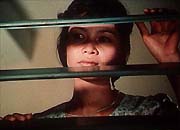
It is the story of its heroine Nguyệt who, to the peril of her life, does not hesitate to save a wounded young man known for his subversive activities by the south vietnamese police during the war. She tries to hide him in her sampan. Once peace is returned, this young man becomes an important communist cadre. The girl tries to find him because she continues to harbor deep feelings for this man. Unfortunately, she feels afflicted and betrayed because this man pretends not to know her and does not like to recollect the troubling periods of his life… She tries to remake her life with her former lover Sơn whom she rejected a few years earlier and who had the occasion to spend a few years in the reeducation camp for having the offence of being enlisted in the south vietnamese army.
In spite of the few things in their constitution, the boats, in particular, the sampans (đò ngang ) continue to charm the Vietnamese. They do not hésitate to integrate them not only in their everyday life but also in the songs and the poems. The songs » Con Thuyền Không Bến » ( The sampan without dock ) from the composer Ðặng Thế Phong and Ðò Chiều ( the sampan of the Evening ) from Trúc Phương going back to several decades and several generations continue to be appreciated and show at such point the profound attachment of all the Vietnamese to their rudimentary boats.
As for the poems describing them, there is only the Vietnamese having the occasion to take the vat who manages to appreciate the finesse and the beauty found in the verses because one perhaps rediscovers through these poems a fragment of one’s life so animated and so closely hidden in one’s memory with more emotions and sadness than joy and happiness. By reading the following verses,
Trăm năm đã lỗi hẹn hò
Cây đa bến cũ con đò khác đưa
Our rendezvous did not take place a long time ago
The banian and the dock are always the same but the sampan has changed owner.
The reader could realize that he is also caught up as so many other Vietnamese by memories that he thinks of erasing from his memory with the passing of the years. He cannot continue to sadden himself as that could be made when one was young and in love through the two following verses:
Tương tư thuyền nhớ’ sông dài
Tương tư là có hai người nhớ’ nhau
It is no longer worth seeing each other again
It is best to leave definitively when one loves intensely
But one should have the courage to forget when the sampan is no longer there as that was said in the following four verses:
Vô duyên đã lỗi hẹn hò
Mong làm chi nữa con đò sang sông
Thôi đành chẳng gặp là xong
Nhớ thương bền chặt bền lòng ra đi
One misses the chance to be at the rendezvous
One no longer hopes when the sampan has already left
It is no longer worth seeing each other again
It is best to leave definitively when one loves intensely
What becomes of her at this moment? Is she dead or happy? Does she deserve the life she leads? Is she like the young boatwoman, sister Tham who saved many people from drowning and who died drowning without anybody rescuing her in the story « Chảy đi sông ơi ( Run, my river, 1988 ) » of the talented writer Nguyễn Huy Thiệp? Is she like the young boatwoman Duyên who continues to hum a lullaby for her child:
Nước chảy đôi giòng …
…Con sông Thương …nước chảy đôi giòng …
One can go up or descend the current… of the river Love…
one can go up or descend the current..
and never asking questions about the life that was layed out for her just like the river that follows its course to the sea in the short story » Nước Chảy Ðôi giòng ( At counter-current, 1932 ) from Nhất Linh?. These are the questions that the reader overcomed by memories continues to ask intimately. It is also the deep sadness, the poignant pain of the one who no longer has the occasion to find the freshness of his youth through the sampan and its dock which he was accustomed to take at a distant time. He had thought that with time this could erase all the memories as the water of the river evoked in the song with a strange sadness which sister Thắm likes to sing on the bank in the story » Chảy đi sông ơi ( Run, my river, 1988 ) » from Nguyễn Huy Thiệp:
Chảy đi sông ơi
Băn khoăn làm gì ?
Rồi sông đãi hết
Anh hùng còn chi ? …
Run my river
Why be tormented?
The river erases all
Even memories of the heroes…
Chuyện Tình Buồn ( The story of sad love ) of Phạm Duy
(1) Author of two works Bắc sứ Thi Tập ( Collection of poems written during a mission in China ) and Cấn Trai Thi Tập ( Collection of poems from Cấn Trai ).

